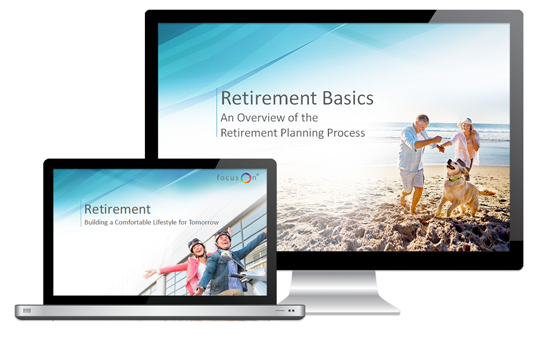The Financial Professional’s Guide to Educational Event Marketing
Creating a successful lead funnel with webinars and seminars

Attracting qualified prospects – and successfully converting them to clients – is a key component of a financial professional’s business plan. For years, seminar marketing has proven to be a reliable method to fill that need. But in today’s digital-first world, are educational seminars still a viable method for attracting prospects? The answer is “Yes!” — when executed correctly.
Here are steps you can take to launch a successful lead funnel using educational webinars and seminars.
Step 1: Target Your Market
As with any marketing strategy, your first step is to determine your target market. What are the attributes of your ideal client? This will help you choose the most appropriate financial topic(s), as well as the location, date and time of your event.
Targeting criteria may include a specific age range, minimum net investable assets, minimum annual household income, marital status, homeownership and geographic location. What are the goals and concerns of your ideal client?
Based on your preferred target market criteria, you can select a topic that will spark interest. For example, individuals aged 55 to 65 are likely interested in Social Security and retirement income strategies. For millennials, interesting topics include investing and retirement planning. Be sure to include an attention-grabbing title and utilize a presentation that includes a mix of statistics, charts, images and messaging to support your concepts. The goal of your presentation is to educate and build trust while compelling attendees to follow up one-on-one to delve deeper into their personal financial needs.
Step 2: Virtual or In-Person?
Thanks to the convenience of technology, you are no longer limited to in-person events. Individuals of nearly all target markets are now familiar with webinars – and many prefer the convenience that webinars provide.
Of course, an in-person event has its benefits as well. It is often easier to establish a personal connection with attendees at a seminar. Plus, even though there may be fewer attendees at an in-person event, you’re more likely to fully capture their attention and develop a trusting relationship.
One recommended strategy is to alternate between webinars and seminars with your prospecting events. Start with a shorter webinar and then follow it up with a more in-depth, in-person seminar that builds on your webinar topic. This creates a lead funnel where individuals can get to know you and your brand before they meet with you in person. Alternating between virtual and in-person events also helps accommodate for a variety of schedules and individual needs.
Step 3: Determine Location and Venue
SEMINARS
When hosting an in-person seminar, it’s best to find a location as accessible and convenient to your invited guests as possible. For suburban areas, a general rule of thumb is to identify a location as close to the center of a 20-mile radius as is practical.
The most popular venue is a restaurant that has a meeting room capable of accommodating 20 to 30 people for a meal. Here’s why: Broadridge has found that the early evening hours result in optimal attendance, since this is the time of day most individuals can attend. The professional course of action is to provide a meal to ensure that your guests are not rushed and can give you their full attention.
When choosing a restaurant, think about where your target audience would like to go to dinner. Keep in mind that the restaurant manager is like a business partner and needs to understand your objectives. You can work together to make the evening pleasant for your guests and a success for you.
WEBINARS
Webinars allow you to attract prospects from outside your geographic area, which is a great benefit as investors become increasingly open to working with professionals whose businesses are not close by.
However, location and venue still matter when you are hosting a virtual event!
You need to consider the presentation backdrop for your live welcome and introduction. For this, you can use your actual location or a virtual background. Either way, it’s recommended that your background is professional and inviting and establishes you as a trusted subject-matter expert.
You also need to choose a webinar platform that provides tools to create an engaging experience and is easy to navigate. Popular platforms include GoToWebinar, Skype, Slack, Webex and Zoom.
Step 4: Seminar Marketing Calendar - Dates and Times
Generally, the calendar is fairly open when it comes to scheduling webinars and seminars, with Tuesday, Wednesday and Thursday as the best-attended days.
Of course, you want to avoid holidays. And with so many holidays falling from late November through December, it is recommended that you avoid the week before Thanksgiving through the end of the calendar year. For the remaining months, schedule events around federal, state and local holidays and events, including popular sporting events and local festivals.
When selecting dates, it’s important to provide your prospects with options, so they can choose from three or four dates to attend. Not everyone will be available for only one date, so multiple dates within a two-week window will usually increase registrations by 30% to 40%. You’re already investing time and resources into your presentation and event marketing, so this is a great way to maximize your ROI.
SEMINARS
Evening events should begin between 6:00 and 7:00 pm, depending on travel patterns. If your area has heavy traffic, a 7:00 pm start time may be preferable.
When holding a dinner seminar, the question always arises whether to feed guests first or present first. Dinner first is largely recommended, as hunger will create an unnecessary distraction for your guests. Allow 40 minutes to serve the food and clear the tables before presenting.
WEBINARS
Webinars allow for daytime hours, as professionals and households can join from the comfort of their office or home. Popular times range from 10:00 am to 2:00 pm, with the preference being 11:00 am. With a higher potential for distractions (co-workers, family, email, etc.!), it’s important to schedule your webinars to last no more than 60 minutes, with 30 to 45 minutes being a desired time range.
Step 5: Attracting Attendees – The Invitation Process
There are many methods for attracting attendees for your seminars and webinars, with the main ones including direct-mail invitations, email, social media and targeted digital ads. You also want to highlight your upcoming events on your website, as well as ensure that your website and social media profiles are all up-to-date prior to sending out invites. Prospects will use your website and social media profiles as a validation tool for who you are and the services you offer; this information will help influence whether they attend your event.
No matter which method(s) you choose, it’s important to send reminders prior to the event. For virtual events, you should send out a digital calendar item so that registrants can easily access the link to attend the event. For in-person events, you can also send out a digital calendar that includes the event time, address and driving directions. Reminder phone calls are also appropriate for in-person seminars.
DIRECT MAIL
In today’s digital-first world, it may be surprising to see direct-mail invitations included in this list, but the truth is that direct mail still works when it comes to in-person events! For webinars, digital methods are recommended.
When utilizing direct-mail invitations, you want to work with a reliable direct-mail service that can provide you with a list of at least 5,000 demographically defined households within a 15- to 20-mile radius of your seminar location. Invitations should be scheduled to arrive at household addresses no later than 10 calendar days before the first scheduled seminar date.
For the actual mail piece, a professionally designed “wedding style” invitation has proven to be successful, as the larger envelope stands out from typical business correspondence. Include compelling information on the envelope, including the restaurant name, so the invitation gets opened. The invitation itself should also be compelling, with important content including the presentation topic and outline, a picture and brief bio of the presenter, registration instructions, your business website URL, and three or four dates and times available for attendance. Broadridge has professional direct-mail invitations that coordinate with specific seminar presentations.
DIGITAL
Email, social media and digital advertising all work well to attract prospects to your in-person and webinar events. Emails allow you to reach out to existing contacts, while targeted social media and digital advertising will help you attract new prospects who meet your target market demographics.
As with direct-mail invitations, you should highlight key pieces of information in your email invitations: financial topic and outline, information about the presenter, registration instructions, a link to your website and times available for webinar attendance. Broadridge has email campaigns that coordinate with specific webinar presentations.
Thanks to hyper-targeting capabilities now available through the various social media and digital advertising networks, financial professionals can now deploy digital advertising campaigns to attract qualified attendees to their seminar and webinar events. Campaigns should point to a landing page that provides event details and easy event registration to increase the number of registrants. Registration forms should include first and last name, email address, phone number and company name or job title. This information will help with event reminders, as well as create a database of pertinent information for post-event prospect nurturing
Step 6: When the Guests Arrive
SEMINARS
You will need a registration table for when your guests arrive. A typed attendance list will validate and impress your guests that they were expected. Provide a workbook, evaluation form, tent card with the individual’s first name and a pen or pencil for each attendee. Please, no sales material. Your guests assume the seminar will be educational, not sales oriented. This will help build trust and rapport.
We encourage you or one of your associates to escort the guests into the room, introducing them to others and directing them to their seats. This warm and welcoming experience will help motivate attendees to come to your office later for a complimentary, no-obligation consultation.
WEBINARS
About 15 to 20 minutes before the webinar starts and attendees log in, test the audio and visual setup. If possible, play inviting music as attendees log in, and have your title slide on the screen so prospects know they’re attending the right event. You can check in periodically with a greeting as the attendees gather and use chat functionalities to welcome and interact during the arrival period.
It’s helpful to include a digital workbook to reinforce the messaging of your presentation and provide a reminder of your services. If it’s available through your webinar platform, you can make this a downloadable asset. Otherwise, you can send a link for download during a post-event email.
Start your event on time with a live welcome and introduction. To help make a personal connection, use live video so everyone can put a face to your name. Then, once it’s time to start the presentation, cut over to full-screen presentation mode to help limit distractions.
Enlist the help of an assistant to help monitor attendance numbers and the chat box so you can focus on your presentation.
Lastly, don’t forget to record your webinar! This gives attendees the ability to re-review your messaging post-event as well as create a nice touchpoint you can leverage for any registrants who could not attend the live event.
Let’s talk about what’s next for you
Our representatives and specialists are ready with the solutions you need to advance your business.
Want to speak with a sales representative?
| Table Heading | |
|---|---|
| +1 800 353 0103 | North America |
| +442075513000 | EMEA |
| +65 6438 1144 | APAC |
Thank you.
Your request has been successfully submitted. A representative will contact you shortly.



